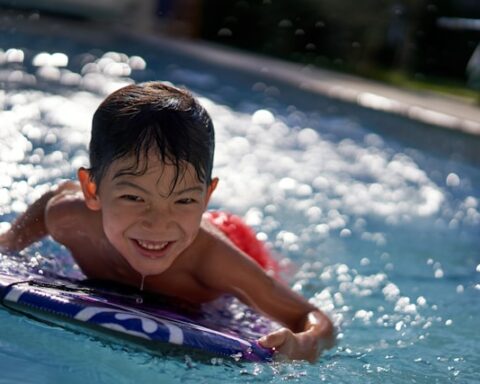Among all the five oceans of the world, the Arctic Ocean is different and unique due to its location at the north pole. Both the North Pole and the South Pole have been of prime interest for kids due to their unique positions on the earth and the extremely cold climate that exists throughout the year. Due to this extreme climate the geography, flora, and fauna are unique and interesting to study. On this page, we have laid down a complete set of Arctic Ocean Facts for Kids that will help kids in learning all about the Arctic Ocean.
Arctic Ocean Facts for Kids
1. What is the Arctic Ocean
- The Arctic Ocean is the large expanse of saline water that surrounds the north pole of the Earth.
- It is located within the Arctic circle and occupies the area around the North Pole.
- It is the smallest ocean among the five oceans in the world.
- It is also the shallowest ocean among all the five oceans.
- The International Hydrographic Organization classifies it as an ocean while some oceanographers just call it the Arctic.
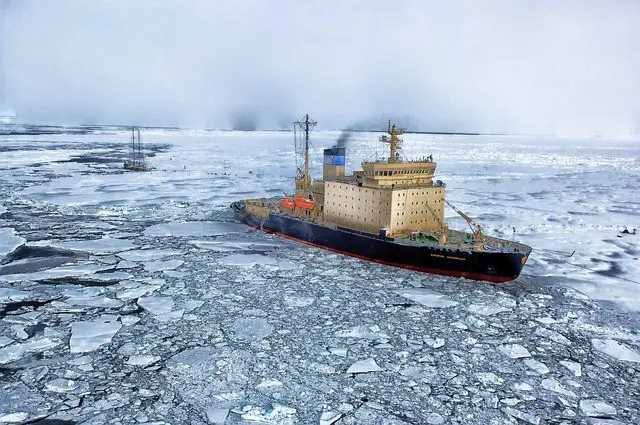
2. Arctic Ocean Meaning
- The word the Arctic is derived from the Greek word “arktikos” which means “near the Bear, northern”, which refers to the constellation “Great Bear” or the “Little Bear” which are visible in the northern portion of the celestial sphere.
- The Arctic Ocean means the great mass of ice-covered water that surrounds the north pole and lies within the Arctic Circle.
3. Where is the Arctic Ocean – Arctic Ocean Location
- The Arctic Ocean is located in the middle of the Northern Hemisphere which is called the Arctic north polar region.
- It is almost circular with the North Pole approximately at its center.
- It is surrounded by Norway, Russia, Alaska, Canada, and Greenland. It connects with the Atlantic Ocean between Greenland and Europe, and with the Pacific Ocean by Bering Strait situated between Siberia and Alaska.
- The coordinates for the Arctic Ocean are 65.2482° N, 60.4621° W.
4. What Three Continents does the Arctic Ocean Touch
- The Arctic Ocean touches the following:
- Europe
- Asia
- North America
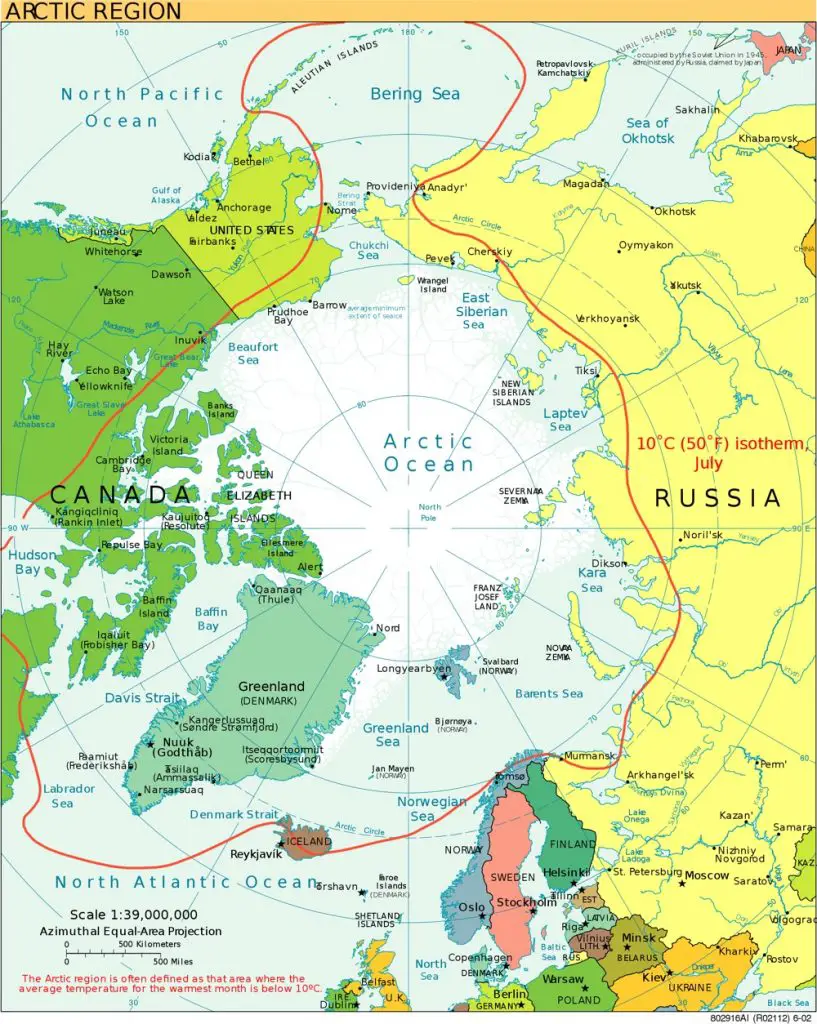
Which Continent is Closer to the Arctic Ocean
- The following continents are closer to the Arctic Ocean:
- Europe
- Asia
- North America
5. Who Owns the Arctic Ocean – Arctic Ocean Countries
- As per International Law, the North Pole and the surrounding Arctic Ocean region are not owned by any country in the world.
- The ownership of the Seas and Oceans is governed by the Law of the Sea Treaty.
- According to the Law of the Sea Treaty, each country can have ownership of natural resources found on, above, and below the ocean floor for about 200 nautical miles (i.e. 230 miles or 371 km) from their natural shoreline.
- So as per the above-stated law, major portions of the Arctic Ocean are owned by:
- Canada
- United States of America
- Russia
- Denmark
- Norway
- Finland
- Sweden
- Iceland
Arctic Ocean Norway
- Norway’s territory that is in the Arctic Region includes the following counties:
- Nordland
- Troms
- Finnmark
- Svalbard archipelago
- Jan Mayen Island
- The above territory when combined covers almost 50% of Norway
- About a tenth of the Norway population lives in these areas.
- The total area of Norway’s maritime areas in the Arctic is about 1 500 000 km square.
Arctic Ocean Russia
- About 2 million-square-mile (5.2 million-square-kilometer) of the Russian territory forms part of the arctic circle.
- This area consists of snow-covered land, ice, large glaciers, mountains, rocks, lakes, bogs, tundra, and permafrost.
- More than 12 ethnic groups of people live in Arctic Russia.
- The area is rich in huge mineral and natural reserves.
- Arctic Russia comprises the following areas:
- Magadan Oblast
- Yakutia
- Kamchatka Oblast
- Murmansk Oblast
- Arkhangelsk Oblast
- Komi Republic
- Tyumen Oblast
- Khabarovsk Krai
- Irkutsk Oblast
- Sakhalin Oblast
- Krasnoyarsk Krai
- all islands of the Arctic Ocean
- the Bering Sea
- the Sea of Okhotsk.
- The Bering Sea is situated between Alaska and Siberia, which is rich in fishery and is home to whales, polar bears, walruses, and fur seals.
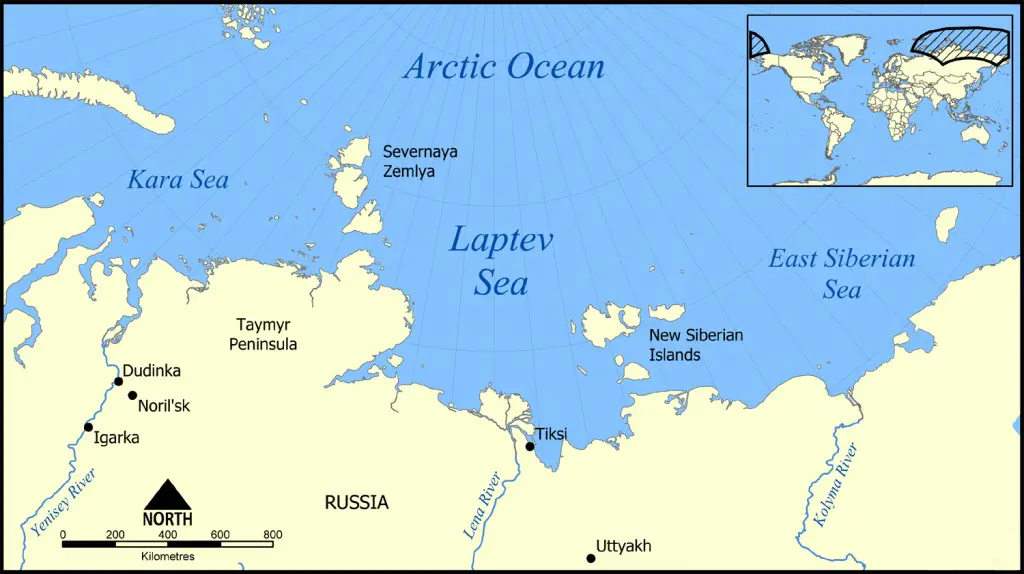
Arctic Ocean Canada
- About 40% of the landmass of Canada is made up of the Canadian Arctic.
- The number of inhabitants of the Canadian Arctic is more than 100,000.
- However, the population of the Canadian Arctic represents only 1% of the total population of Canada.
- It is referred to as Northern Canada and includes the following territories:
- Yukon
- North-West Territories
- Nunavut
Arctic Ocean Alaska
- The northern areas of the US state of Alaska close to the Arctic Ocean are called Arctic Alaska.
- They include:
- North Slope Borough
- North-West Arctic Borough
- Nome Census Area
- Yukon-Koyukuk Census Area
- These areas are mostly mountain ranges and coastal plains.
- Most of these areas are only accessible by aircraft or snowmobile in good weather.
- The current settlements in Arctic Alaska are mostly driven by the extraction of petroleum.
9. Arctic Ocean Characteristics
- The Arctic Ocean is the smallest and shallowest ocean, covering only 3% of the earth’s surface.
- Its surface area is 14.06 million square kilometers and its average depth is 1,038 meters.
- It is located in the Northern Hemisphere.
- It is completely covered by ice in winters and partially covered by ice in summers.
- There are three types of ice covering the Arctic Ocean:
- Pack Ice
- Polar Ice
- Fast Ice
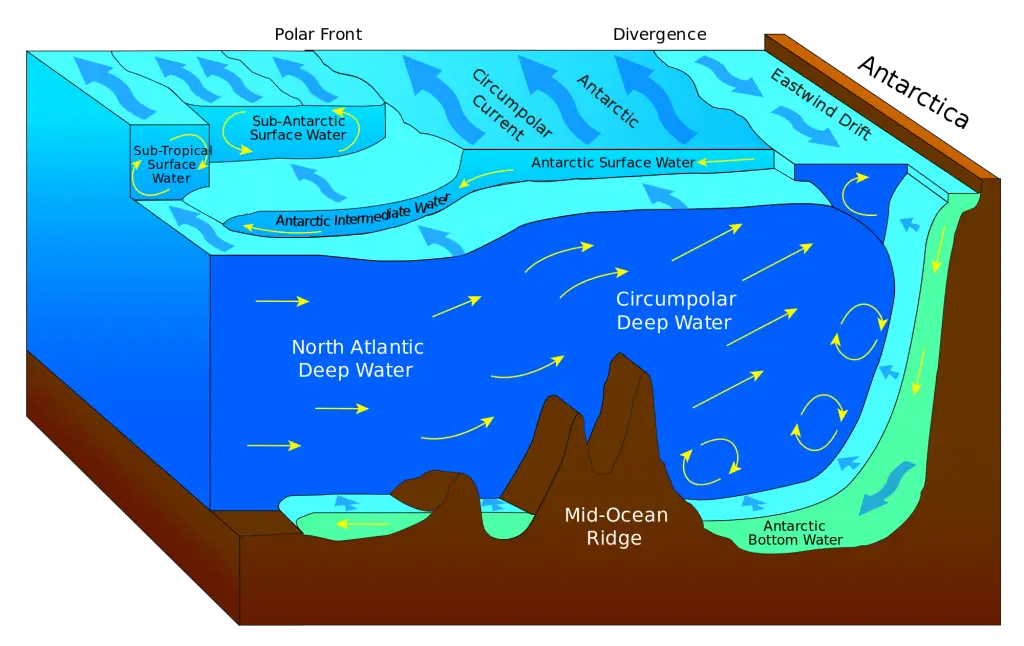
10. How Big is the Arctic Ocean – Arctic Ocean Size
- The Arctic Ocean is the smallest and shallowest ocean, covering only 3% of the earth’s surface.
- Its surface area is 14.06 million square kilometers and its average depth is 1,038 meters.
11. What is the size of the Arctic Ocean – Arctic Ocean Area
- The surface area of the Arctic ocean is 14.06 million square kilometers.
Is the Arctic Ocean the Smallest Ocean
- Yes, the Arctic Ocean is the smallest and shallowest ocean on earth.
12. How Deep is the Arctic Ocean – Arctic Ocean Depth
- The Arctic Ocean is the shallowest, however, it is still very deep.
Average Depth of Arctic Ocean
- The average depth of the Arctic Ocean is 1,038 meters.
Deepest Part of the Arctic Ocean
- Its deepest point is 5,450 meters deep at Litke Deep in the Eurasian Basin.
How Deep is the Arctic Ocean in Feet
- The average depth of the Arctic Ocean in feet is 3,406 ft.
- Its deepest point is 17,880 ft deep.

13. How Cold is the Arctic Ocean – Arctic Ocean Temperature
- The temperature in the Arctic Ocean remains very low throughout the year.
- In winters, the temperature ranges from -30°C to -35°C.
- In summers, the temperature is 0°C due to the melting of ice.
- The temperature is the lowest in January and highest in July.
What is the Average Temperature of the Arctic Ocean
- The average surface temperature of the Arctic Ocean is constantly near the freezing point of seawater which is −1.8 °C (28.8 °F)
Is the Arctic Ocean the Coldest
- Yes, the Arctic Ocean is the coldest ocean on earth.
14. Bottom of the Arctic Ocean
- The bottom of the Arctic Ocean is marked by:
- Fault Block Ridges
- Abyssal Plains
- Ocean Deeps
- Basins
15. Arctic Ocean Seas
- The Arctic Ocean shares borders with 5 marginal seas.
- The seas of the Arctic Ocean along with their area are:
- Barents Sea (542,473 sq miles / 1,405,000 sq km)
- Kara Sea (339,770 sq miles / 880,000 sq km)
- Laptev Sea (276,000 sq miles / 714,837 sq km)
- Chukchi Sea (224,711 sq miles / 582,000 sq km)
- Beaufort Sea (183,784 sq miles / 476,000 sq km)
- Lincon Sea (40,000 sq miles / 64,000 sq km)
- Wandel Sea (22,007 sq miles / 57,000 sq km)
16. Arctic Ocean Currents
- There are two main currents in the Arctic Ocean:
- The Beaufort Gyre
- The Transpolar Drift Stream
- The water in the Arctic Ocean usually revolves in a clockwise direction around the polar ice cap.
- Coldwater flows from the Pacific Ocean to the Arctic Ocean through the Bering Strait. This colder water is mixed with river water flowing into the Arctic Ocean and flows to the Beaufort gyre where strong winds force this water to flow in a clockwise direction.
17. The Arctic Ocean Salt Water – Arctic Ocean Salinity
- The average salinity of the Arctic Ocean is 30 ppt (parts per trillion) which is comparatively lower than other oceans.
- The icebergs formed on land during the winter do not contain any salt. When these icebergs melt, the freshwater flows into the ocean thus decreasing the salinity.
- The freezing of saltwater to ice also decreases the salinity.
18. Arctic Ocean Islands
- There are 116 islands in the Arctic Ocean.
- These islands are fragments from the Continents surrounding the Arctic Ocean.
- Only some of these islands are inhabited by people, while others are not due to extremely cold weather.
- Some of these islands are:
- Baffin Island (Canada)
- Traill Island (Denmark)
- Bjarnarey (Iceland)
- Bear Island (Norway)
- Dikson Island (Russia)
- Barter Island (United States)
Largest Island in the Arctic Ocean
- The largest island in the Arctic Ocean is Baffin Island with an area of 507,451 sq km.
- It is located in the Canadian Arctic region.
19. Arctic Ocean Climate
- The climate of the Arctic Ocean is highly affected by solar radiation and rivers flowing from the surrounding landmasses.
- These factors influence the winds, precipitation, and temperature in the Arctic Ocean.
- Generally, the winters are long and cold. And the summers are cool and short.
- The Arctic Ocean is very cold with the presence of ice and snow because it is located at a higher latitude.
- There are four seasons in the Arctic Ocean:
- Winter (November through February)
- Summer (May and June)
- Spring (March and April)
- Autumn (September and October)
- In winters, the temperature ranges from -30°C to -35°C.
- In summers, the temperature is 0°C due to the melting of ice.
- The temperature is the lowest in January and highest in July.
- The winds flowing in the Arctic Ocean have an average speed of 4 to 6 meters per second throughout the year.
20. Arctic Ocean Map

21. What Lives in the Arctic Ocean
- The Arctic Ocean is one of the coldest and most inaccessible areas on earth.
- Despite the harsh climate and living conditions, the Arctic Ocean is bustling with life.
- The different types of creatures living in the Arctic Ocean are:
- Several species of mammals (Whale, Polar Bear, Walrus)
- Birds
- Fish
- Sea Plants
22. Animals that Live in the Arctic Ocean – Arctic Ocean Animals
- There are several species of animals that inhabit the Arctic Ocean.
Arctic Ocean Species
- The different species of creatures living in the Arctic Ocean are:
- Several species of mammals (Whale, Polar Bear, Walrus)
- Birds (Snowy Owl, Puffin)
- Fish (Cuttlefish, Jellyfish)
- Sea Plants (Algae)
Arctic Ocean Whales
- The different types of whales found in the Arctic Ocean are:
- Blue Whale
- Humpback Whale
- Fin Whale
- Killer Whale
23. What Plants Live in the Arctic Ocean – Arctic Ocean Plants
The Arctic Ocean receives very little sunlight throughout the year which makes it very hard for plants to grow and survive. Given the harsh climatic conditions, some species still manage to grow and survive. These plants are:
-
Arctic Plankton
- Plankton is an aggregate of plants and animals which drift in large groups in oceans.
- A certain plant version of the Plankton, Phytoplankton is regularly found in the Arctic Ocean.
- There are 70 different species of Phytoplankton in the Arctic Ocean.
- They are vital for life in the Arctic Ocean because they are at the bottom of the food chain.
- They serve as food for the Copepods and Humpback Whales.
-
Arctic Seaweed
- There are around 150 different species of seaweed in the Arctic Ocean that are capable of surviving at low temperatures and low sunlight.
- Some of these seaweeds are Furcellaria, Ceratocolax, and Halosacciocolax.
- They do not serve as food for the marine animals, however, once they wash up to the shore, they serve as food for the land animals like the arctic hare and polar fox.
-
Arctic Moss
- The Arctic Moss is a freshwater plant, found at the bottom of tundra lake beds.
- It is the slowest-growing and longest-living plant.
24. Arctic Ocean Plants List
The plants found in the Arctic Ocean are:
- Arctic Ocean
- Arctic Seaweed
- Arctic Moss
25. Arctic Ocean Ice
- Most of the Arctic Ocean is covered with ice all the time whose thickness ranges between 1 to 10 meters.
- One-third of the Arctic Ocean is a continental shelf (shallow).
- Ice is not present over the continental shelf for some time of the year. However, it is present over the deep parts throughout the year.
26. Arctic Ocean Melting
- The thickness of the ice in the Arctic Ocean has decreased about 6% over the last two decades.
- This suggests that the ice cover in the Arctic Ocean is gradually melting.
27. Swimming in the Arctic Ocean
- The Arctic Ocean is one of the coldest areas on earth.
- The temperature of the water is -0.5°C which is quite low for swimming.
- Professionals swimmers who have taken the challenge to swim in the Arctic Ocean described it as a terrifying experience.
- Coldwater causes your body to hyperventilate, which reduces the blood flow to the brain.
- Most untrained people would die in a short time if they tried to jump in the Arctic Ocean.
28. Arctic Ocean Resources
- The Arctic Ocean is very rich in living and mineral resources.
- The living resources are primarily the fisheries.
- The mineral resources include:
- Oil
- Natural Gas
- Iron Ore
- Copper
- Zinc
- Nickel
- Zinc Phosphates
- Diamonds
29. Fun Facts About the Arctic Ocean
- The area of the Arctic Ocean is almost 5.4 million sq. miles, which is almost the same size as Russia.
- Various marine animals are living in the Arctic Ocean, which includes Jellyfish, Whales, Fish, and Walruses.
- There are four different whale species found in the Arctic Ocean.
- There are more species of fish found in the Arctic Ocean than anywhere else in the world.
- The Arctic Ocean has the lowest salinity among all the oceans of the world.
- The famous ship, Titanic, ran into an iceberg that had broken off from a glacier in the Arctic Ocean.





